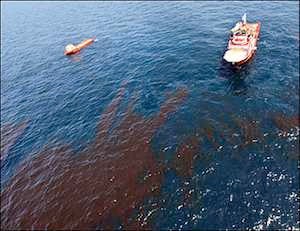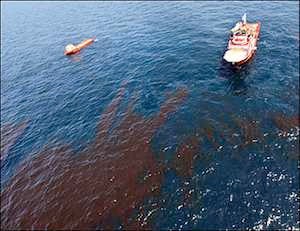 Grant from fund established by BP following Gulf of Mexico oil spill
Grant from fund established by BP following Gulf of Mexico oil spill
KINGSTON, R.I. – October 24, 2011 – The use of chemical dispersants to clean up the Deepwater Horizon oil spill last year in the Gulf of Mexico led to discussions about the development of more effective and safer dispersants. As a result, a consortium of scientists has been awarded $10.4 million to study the behavior and transport of the dispersants and to develop new dispersants for use in future spills.
University of Rhode Island chemical engineering professors Arijit Bose and Geoffrey Bothun, both investigators at the Rhode Island Consortium for Nanoscience and Nanotechnology, are among those receiving funding. They will use $560,000 of the award to study the effectiveness of environmentally friendly nanoparticles instead of chemical dispersants as a means of stabilizing oil droplets in seawater.
According to the URI scientists, the chemical dispersants used in the Gulf of Mexico are soap-like molecules designed to emulsify the spilled oil and keep it dispersed in tiny droplets suspended in the water long enough for naturally occurring bacteria to consume the oil.
“The goal is to keep the oil within the water column, or under the surface, so that naturally occurring ocean bacteria can eat it. If the oil rises to the surface, the lighter components evaporate, leaving behind the heavy components that are difficult to disperse,” explained Bose. “These heavy portions make their way to shore, with subsequent damage to the ecosystem and food chain. It’s important to contain all of the components of the oil in the water column so the bacteria can do their job.”
Bose will study how carbon-based nanoparticles, rather than chemical dispersants, can be used to stabilize the oil droplets in the water and ensure that the droplets do not coalesce and become too big for the bacteria to feed upon.
“Carbon is biofriendly and can absorb toxic aromatic hydrocarbons from the oil, preventing these toxic components from entering the water,” said Bose. “The microbes like oil droplets of about 100 microns in size,” Bose said. “That’s the right size chunk for them to eat.”
Once the nanoparticles attach to the oil droplets, they never separate from them, unlike chemical dispersants, which can migrate away from the oil, allowing the oil to combine into drops that are too large for the microbes to eat. . Larger drops also tend to migrate to the surface more easily than smaller drops.
Bothun’s approach to studying the use of nanoparticles as dispersants is to use porous silica particles that are loaded with nutrients that the bacteria need to survive.
“It’s like putting a little candy on the particles to attract the microbes,” explained Bothun, who will collaborate on his research with Vinka Craver, URI assistant professor of civil engineering. When these particles are used as dispersants, the candy is at the interface between oil and water where the bacteria want be. “This will enhance the growth of the microbes and their desire to eat the oil,” he added.
The URI scientists say that while their research is focused on oil spills, it can also serve as a platform for developing other applications, including novel materials for batteries and fuel cells and novel drug delivery vehicles.
In addition to Bose and Bothun, Sunshine Menezes is a critical part of the URI dispersants team. The director of the Metcalf Institute for Marine and Environmental Reporting, which is based at the URI Bay Campus, she will work with the scientists and journalists to determine the best way to disseminate the results of the research to the general public.
The consortium studying oil spill dispersants, led by Tulane University, includes 42 scientists from 21 universities. Funding was provided by the Gulf of Mexico Research Initiative, which was set up by oil company BP to administer a $500 million fund it established for independent research over 10 years into the effects of the Deepwater Horizon oil spill and how to better deal with future spills.

